Last week’s photo of my hand holding a bunch of cooking gadgets, including dumpling spatulas purchased at the Wok Shop in San Francisco caused several people to ask on Facebook and Instagram, “What is a dumpling spatula?” It’s a nifty gadget that dumpling geeks like me and professional dumpling makers use to efficiently place filling on wrappers without the filling sticking. Answering their questions prompted me to look through my kitchen at the tools I use most for making Asian dumplings. I've been collecting dumpling making implements for years and will save the esoteric ones for another post. These are my go-to dumpling tools.
After watching dumpling makers through shop windows use bamboo spatulas to place their filling, I wanted one. I’d not seen them in California and on a trip to New York City in 2007, I found a bunch at a restaurant supply shop in Chinatown. I chose the one on the left below. “Number one” felt good in my hand and was made of bamboo with character. It was lovely then as it is now, aged with my repeated use. I should have bought more because on my next trip to NYC, the store didn’t have any. Obviously the local dumpling makers knew a good thing.
It was years until I’d see the spatulas again. The second two came from a restaurant supply shop in Kowloon, Hong Kong. My bamboo spatula expanded with the two new ones from the Wok Shop; they are awfully big in my hand. My husband likes to use the bamboo spatulas for stirring up his almond butter and I’m encouraging him to use the bigger ones.
These are amazingly useful tools. Note the tapered tip of the bamboo ones. Those had to be made by hand.
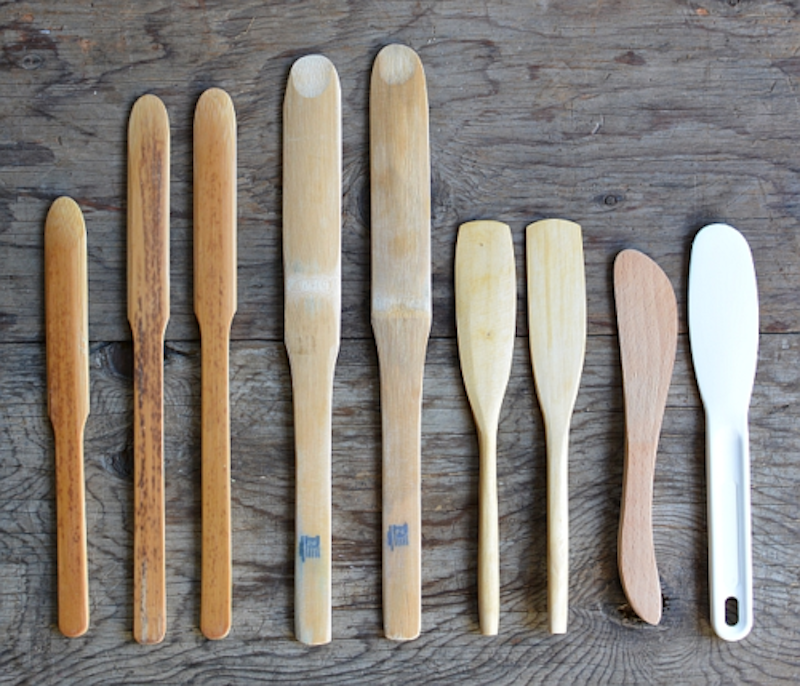
Size matters for these spatulas because like a knife, they need to fit your grip. That’s why I picked up the mini boat oar-shaped spatulas from LAX-C, a Thai restaurant supply place in Chinatown, Los Angeles. I also found the wood one at Sur La Table, which is okay in a pinch. It’s not thin enough.
Last Wednesday, Wok Shop owner Tane Chan suggested the small white nylon spreader, which is usually a cake decorating tool. “I bet it’s good for wontons,” she said.
Chan is smart. I tried out the nylon spatula and it turned out to be great -- not just for dumplings but also for spreading mayo, etc. on sandwiches and knocking the milk residue clinging to a saucepan.
Do you need a dumpling spatula? A dinner knife, butter knife, teaspoon or fork will do. But, if you see a cheapie spreader like this one, give it a try. I think you’ll like it.
Wood dowel rolling pin
For pot stickers, soup dumplings, momos, and bao – rolling out the dough is done mostly easily with a wooden dowel rolling pin. In Asia, the dowels come in various widths and lengths. Some are tapered at the ends and others not. The first one I purchase in on the right below. It’s been with me since the early-1990s, after I returned from living in Hong Kong and wanted to try my hand at making dumplings wrappers from scratch. I bought it in Chinatown, Los Angeles, at a restaurant supply shop. Note that I LOVE shopping at Asian restaurant supply shops.
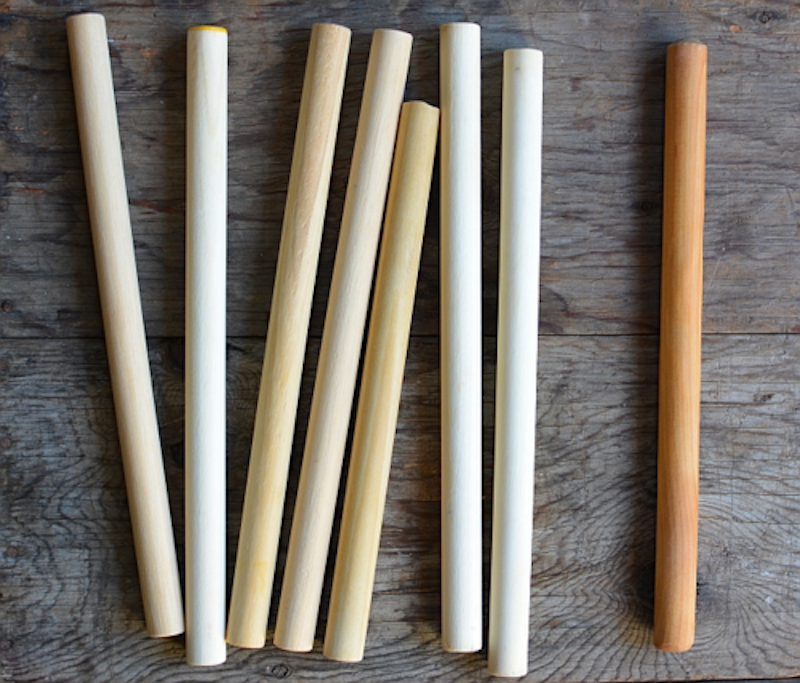
The other dowels are what I bring to class and travel with. They’re not as heavy as the first one I bought.
How to make dowel rolling pins for dumpling rolling
Head to a hardware or home improvement store and buy a ¾-inch (2 cm) wide, 36-inch (1 meter) long dowel. If you're not handy like me, ask the store to cut the dowels into 12 to 13-inch lengths. Go home and lightly sand it with fine sandpaper. Wash it well, let it dry, then oil it with wood cutting board oil before the first use. You'll have enough for a party!
On Craftsy, a student suggested a plastic fondant rolling pin, which I’ve just ordered. It looks a little thick but may do the trick and it’s dishwasher safe.
Traditionally, rolling out the dumpling wrappers was done entirely by hand with the wooden dowel rolling pins. While I was writing Asian Dumplings, I was a team of one and needed assistance. If I couldn’t repeatedly get through batches of 32 wrappers alone, how could I expect you to?
Tortilla press for dumplings
So I took a multicultural short cut and used a Mexican tortilla press to reduce the rolling time by 50 percent to make pot stickers, mandu and the like. The press does 100 percent of the work for white wheat starch wrappers employed for har gow. How’s that for efficiency?
Made from cast aluminum, plastic, or wood, and reasonably priced, tortilla presses can be found at many spots, including Latino grocers, house ware shops and online. The one I favor is lightweight and made of aluminum by Norpro (below, right). Wood tortilla presses would work too. Cast iron ones are too heavy and over press wheat starch wrappers. In a pinch, use the bottom of a heavy glass bowl, Katie Startzman suggested.
I’ve improvised with a heavy-bottomed pot. Cooking school students I taught have resorted to using meat pounders. (Note that for the thin signature skins of wontons, siu mai, and egg rolls, a pasta machine yields fab results.)
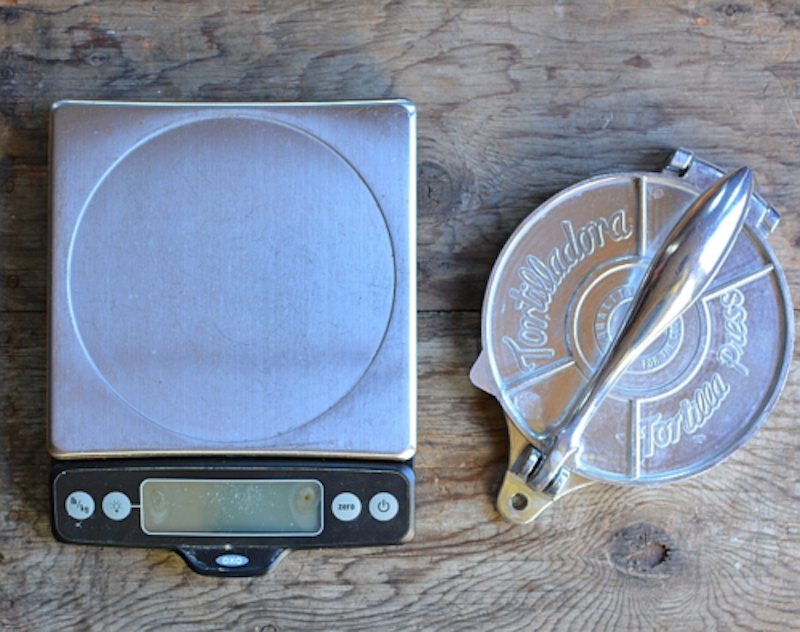
Digital scale and scrapers
While we’re on the subject of metal, a crucial tool in dumpling making – and cooking in general, is a scale. Dumplings fall into the category of pastry. If you want consistency, weigh as much as you can. That’s why my dough recipes in Asian Dumplings all contain weight measurements. Scales don’t lie.
I’ve owned about 4 scales and the OXO scale and Bomata are champs. A digital scale with an 11-pound (5 kg) capacity is all that most home cooks need.
Other items that I find super handy include plastic scrapers that I use to clean out my mixing bowls of doughy bits before washing (I don’t like gummy stuff on my dish washing scrubbies). For cutting dough, I often use a knife but a wood or metal bench scraper is terrific too, plus it’s good for transferring ingredients and overall clean up of your cutting board.
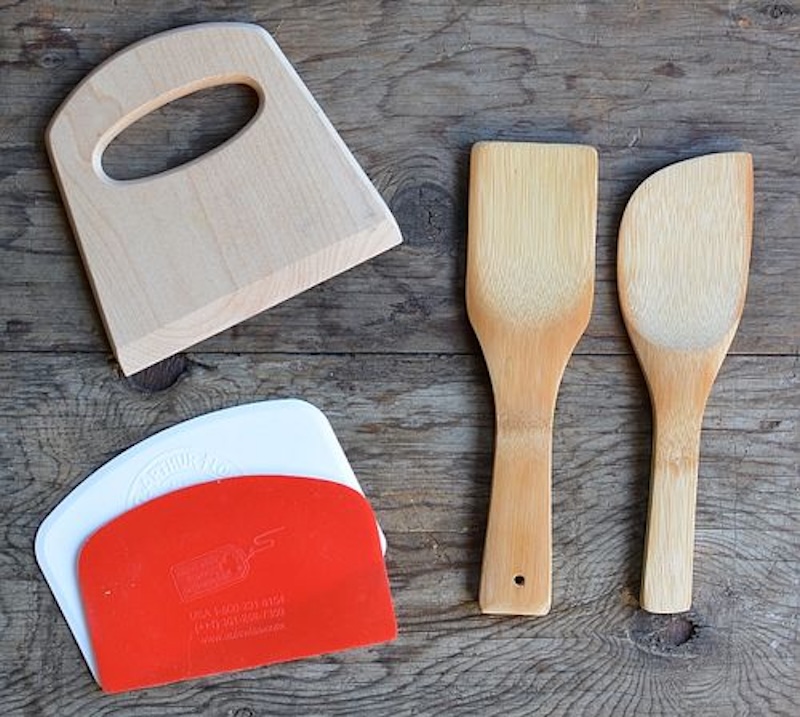
When I first saw short-handled bamboo spatulas at an Asian restaurant supply shop, I thought they were strange mini tools or a kid's toys. They were inexpensive so I bought a couple. Once I started using them, I realized that they are fantastic for stirring dough ingredients together. The short handle allows you to feel the texture of the dough readily and gives you good control, which is especially important when you’re working with lightweight ingredients like wheat starch and tapioca starch that can go flying. A rice paddle works well for mixing too but it lacks the straight-ish edge that the spatulas have.
If you’re into making Asian dumplings, get some of these tools. None of them cost a fortune and they have uses far beyond dumplings. You may have some of the stuff in your drawers already.
Where to find Asian Dumpling tools?
As I mentioned, check out Asian restaurant supply shops in person or online. Go to mainstream cookware shops and craft supply stores like Michael’s. Hardware store dowels can be cut down for dumpling skin rolling! Look around and see what you can use.
Aside from the Wok Shop, I also like Kamei in San Francisco on Clement Street. MV Trading has well stocked stores and an online shop. And, I spend too much money at Daiso, the $1.75 Japanese chain. Many Asian markets have great house ware and cookware aisles or even entire departments so do not leave the store until you peruse their offerings!
Do you have a favorite source for Asian cookware?













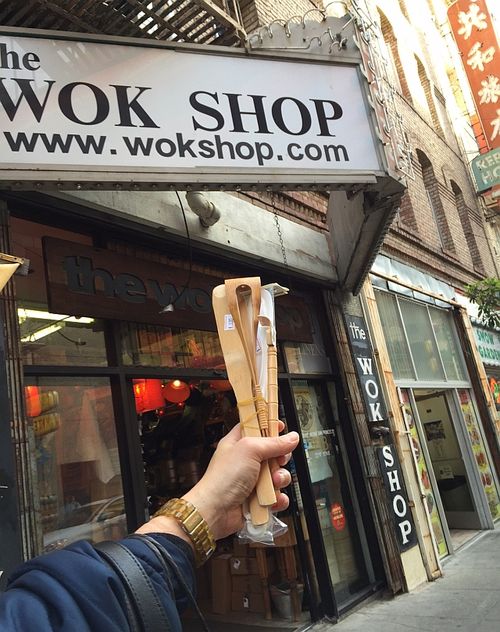




Cheri Thurgood says
I actually keep my scale inside a gallon size ziplock with the zipper on the back side and the writing part on bottom. then I can clean up QUICK, looks funny if you're storing the scale on your counter top but it works amazing for cleanup and I just change the ziplock when I need to.
Andrea Nguyen says
Incredibly smart!!!
Sue Marie says
OMG, what a good idea! Im constantly wiping mine down and it's hard to get at the underside of the weighing part.
Sue Marie says
Thank you for the detailed information on the tools. I'm particularly interested in the rolling pin but from other sites I viewed previously, they say Amazon in Canada does not sell the most recommended size. I've seen another product which to me seems ideal but I"d like your opinion, https://www.amazon.ca/dp/B0841CLV51/?coliid=I2GDN94HP7GTPT&colid=171D4D0OWSM1C&psc=1&ref_=lv_ov_lig_dp_it
Andrea Nguyen says
Wow, I've never seen that before. I suppose you can try it. But how about if you buy a 3/4-inch wooden dowel and cut it to about 10 inches long? It would be an easier and less costly way to get the tool. You'll end up with multiples too!